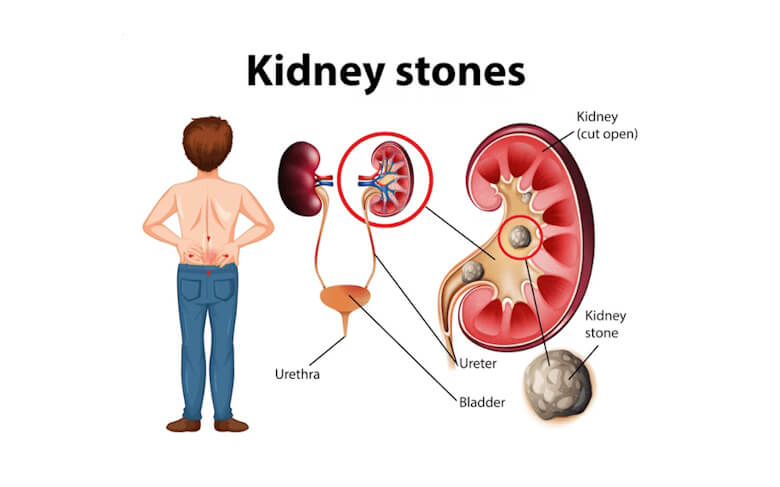Kidney stones are hard deposits that form in the kidneys and can cause severe pain and discomfort. They can vary in size and shape, and can be made up of different types of minerals. In this blog post, we’ll take a closer look at kidney stones, their causes, symptoms, types, diagnosis, and treatment options.
What are Kidney Stones?
Kidney stones are hard deposits made of minerals and salts that form in the kidneys. They can vary in size from tiny grains of sand to larger stones the size of a golf ball. Kidney stones can be made up of different minerals, such as calcium, oxalate, urate, cystine, and struvite.
Symptoms of Kidney Stones
The symptoms of kidney stones can vary depending on the size and location of the stone. Some common symptoms include:
- Severe pain in the side, back, or lower abdomen
- Nausea and vomiting
- Painful urination
- Blood in the urine
- Frequent urination
- Urinary tract infections
Causes of Kidney Stones
There are several factors that can increase the risk of developing kidney stones. Some of these factors include:
- Dehydration
- High levels of calcium, oxalate, or uric acid in the urine
- A family history of kidney stones
- A diet high in sodium or animal protein
- Certain medical conditions, such as gout or inflammatory bowel disease
- Certain medications, such as diuretics or antacids
Types of Kidney Stones
There are several types of kidney stones, each made up of different minerals. The most common types of kidney stones include:
1. Calcium stones:
These are the most common type of kidney stones, accounting for approximately 80% of cases. They are formed when the urine contains high levels of calcium, which combines with other substances such as oxalate, phosphate, or carbonate to form crystals. Calcium stones can be further divided into two subtypes:
Calcium oxalate stones: These are the most common subtype of calcium stones, and are formed when the urine contains high levels of oxalate. Oxalate is found in many foods, including leafy greens, nuts, and chocolate, and can also be produced by the liver. Calcium oxalate stones can be either monohydrate or dihydrate, depending on the structure of the crystal.
Calcium phosphate stones: These stones are less common than calcium oxalate stones and are formed when the urine contains high levels of phosphate. They are usually caused by a genetic disorder or a medical condition that causes the urine to be more alkaline than normal.
2. Uric acid stones:
These stones are formed when the urine contains high levels of uric acid. Uric acid is a waste product that is normally excreted in the urine, but in some people, the levels can become too high, leading to the formation of stones. Uric acid stones are more common in people who have a diet that is high in purines, which are found in foods such as red meat, seafood, and organ meats.
3. Struvite stones:
These stones are also known as infection stones, as they are often caused by a urinary tract infection. They are formed when the urine becomes alkaline, allowing bacteria to multiply and produce ammonia, which combines with magnesium and phosphate to form crystals. Struvite stones can grow very large and can cause damage to the kidneys if not treated promptly.
4. Cystine stones:
These stones are formed when the urine contains high levels of cystine, an amino acid that is normally excreted in the urine. Cystine stones are very rare and are usually caused by a genetic disorder that affects the way the body processes cystine.
Diagnosis of Kidney Stones
If you experience symptoms of kidney stones, your doctor may order tests to diagnose the condition. These tests may include:
Imaging tests, such as X-rays, CT scans, or ultrasounds, to detect the presence of kidney stones
Urine tests, to check for the presence of minerals that can cause kidney stones
Treatment of Kidney Stones
The treatment for kidney stones will depend on the size and location of the stone, as well as the severity of the symptoms. Some common treatments include:
Drinking plenty of fluids to help flush out the stone
Pain medication to manage the pain
Extracorporeal shock wave lithotripsy (ESWL), a non-invasive procedure that uses shock waves to break up the stone
Ureteroscopy, a minimally invasive procedure that uses a small scope to remove the stone
Percutaneous nephrolithotomy (PCNL), a surgical procedure that involves removing the stone through a small incision in the back.
Conclusion
Kidney stones can be a painful and uncomfortable condition, but there are several treatment options available. If you experience symptoms of kidney stones, it’s important to see your doctor for diagnosis and treatment. By understanding the causes, symptoms, types, diagnosis, and treatment options for kidney stones, you can take steps to prevent and manage this condition.

